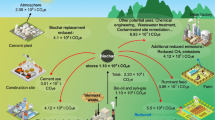Abstract
The present study was carried out in Tehran oil refinery, and HYDRUS-1Dsoftware was used to model the changes of PAHs concentration in the soil column. This investigation was conducted in three steps: at first, the ecological characteristics of Tehran oil refinery were identified, and then the water quality of its wastewater treatment plant was briefly evaluated. Then, a rectangular pilot plant was prepared to compare the potential of PAHs adsorption on soil and the five different adsorbents and optimized the adsorption process. So that, it was layered with various grain sizes of sand from coarse to fine up to 25 cm as a drainage layer. Then, it was packed with a specific measured weight of each of the adsorbents and the soil sample in 15 cm height at separate steps, and the synthetic wastewater began to influence on it. In all experiments, the steady-state regime was achieved by a constant pressure drop. The column pressure head and its conditions were stable during experiments. The adsorption of PAHs on these adsorbents and soil was estimated by measuring the concentration of PAHs in effluences of the drainage every 30 min intervals up to 4 h. In the next steps, the experiments were carried out to separate the PAHs degrading bacteria from soil, to optimize the conditions influencing on the biodegradation of PAH compounds in the laboratory. Finally, HYDRUS-1D was used to model the changes of PAHs concentration in the soil column. The results showed: the soil of the studied area has a high capacity to absorb PAHs. Bentonite has the highest capacity to absorb PAH compounds. Due to the adaptations of indigenous microorganisms in oil-polluted soils, their population increases with the biodegradation of PAH compounds by microorganisms. The maximum bacterial growth was observed at 30 °C and at pH 7.5. The optimum ratio of C:N:P for urea, nitrate and ammonium sulfate were 1:5:100, 1:5:100 and 1:10:100, respectively. There is a good conformity between experimental and laboratory data, and with the passage of time from the second week onwards, the conformity increases.









Similar content being viewed by others
References
Chaîneau CH, Rougeux G, Yéprémian C, Oudot J (2005) Effects of nutrient concentration on the biodegradation of crude oil and associated microbial populations in the soil. Soil Biol Biochem 37:1490–1497. https://doi.org/10.1016/j.soilbio.2005.01.012
Choi H, Harrison R, Komulainen H, Delgado Saborit J (2010) Polycyclic aromatic hydrocarbons. WHO guidelines for indoor air quality: selected pollutants. World Health Organization, Geneva
Clement TP, Wise WR, Molz FJ, A (1994) physically based, two dimensional, finite difference algorithm for modeling variably saturated flow. J Hydrol (Amst) 161:71–90. https://doi.org/10.1016/0022-1694(94)90121-X
Farahani M, Mirbagheri SA, Javid AH, Karbassi AR, Khorasani N, Nouri J (2010) Biodegradation and leaching of polycyclic aromatic hydrocarbons in soil column. J Food Agric Environ 8(2):870–875. (Online ISSN: 1459–0263)
Fodelianakis S, Antoniou E, Mapelli F, Magagnini M, Nikolopoulou M, Marasco R, Barbato M, Tsiola A, Tsikopoulou I, Giaccaglia L, Mahjoubi M, Jaouani A, Amer R, Hussein E, Al-Horani FA, Benzha F, Blaghen M, Malkawi HI, Abdel-Fattah Y, Cherif A, Daffonchio D, Kalogerakis N (2015) Allochthonous bioaugmentation in ex situ treatment of crude oil-polluted sediments in the presence of an effective degrading indigenous microbiome. J Hazard Mater 28(287):78–86. https://doi.org/10.1016/j.jhazmat.2015.01.038
Johnsen AR, Wick LY, Harms H (2005) Principles of microbial PAH-degradation in soil. Environ Pollut 133(1):71–84. https://doi.org/10.1016/j.envpol.2004.04.015
Juhasz AL, Stanley GA, Britz ML (2002) Metabolite repression inhibits degradation of benzo[a]pyrene and dibenz[a, h]anthracene by Stenotrophomonas maltophilia VUN 10, 003. J Ind Microbiol Biotechnol 28:88–96. https://doi.org/10.1038/sj/jim/7000216
Khoyi JK, Farmohammadi S, Noori AS, Padash A (2013) Bioremediation; a nature-based approach towards having a healthier environment. Ann Biol Res 4 (2):43–46 (ISSN 0976–1233. CODEN (USA): ABRNBW. 43. Scholars Research Library)
Mirbagheri SA, Javadifar N, Hasani AH (2016) Modeling Pb transport in soil column and ground water. Bulg Chem Commun 48:205–210. (doi-ds.org/doilink/05.2016 -13212626)
Monticello DJ (2000) Biodesulfurization and the upgrading of petroleum distillates. Curr Opin Biotechnol 11:540–546. https://doi.org/10.1016/S0958-1669(00)00154-3
Mualem Y (1976) A new model for predicting the hydraulic conductivity of unsaturated porous media. Water Resour Res 12(3):513–522. https://doi.org/10.1029/WR012i003p00513
Rivera-Espinoza Y, Dendooven L (2004) Dynamics of carbon, nitrogen and hydrocarbons in diesel contaminated soil amended with biosolids and maize. Chemosphere 54:379–386. https://doi.org/10.1016/S0045-6535(03)00653-2
Romano N, Brunone B, Santini A (1998) Numerical analysis of one-dimensional unsaturated flow in layered soils. Adv Water Resour 21:315–324. https://doi.org/10.1016/S0309-1708(96)00059-0
Rosenberg E, Ron EZ (1996) Bioremediation of petroleum contamination. In: Crawford RL, Crawford DL (eds) Bioremediation: principles and application. Cambridge University, Cambridge, pp 100–124
Sarkar J, Kazy SK, Gupta A, Dutta A, Mohapatra B, Roy A, Bera P, Mitra A, Sar P (2016) Biostimulation of indigenous microbial community for bioremediation of petroleum refinery sludge. Front Microbiol 7:1407. https://doi.org/10.3389/fmicb.2016.01407
Simpson MJ, Clement TP (2003) Comparison of finite difference and finite element solutions to the variably-saturated flow equation. J Hydrol 270:49–64. https://doi.org/10.1016/S0022-1694(02)00294-9
Van Hamme JD, Singh A, Ward OP (2003) Recent advances in petroleum microbiology. Microbiol Mol Biol Rev 67(4):503–549. https://doi.org/10.1128/MMBR.67.4.503-549.2003
Author information
Authors and Affiliations
Corresponding author
Rights and permissions
About this article
Cite this article
Farahani, M., Mahmoudi, D. Optimization, modeling and its conformity with the reality of physico-chemical and microbial processes of petroleum hydrocarbons reduction in soil: a case study of Tehran oil refinery. Environ Earth Sci 77, 329 (2018). https://doi.org/10.1007/s12665-018-7512-5
Received:
Accepted:
Published:
DOI: https://doi.org/10.1007/s12665-018-7512-5




